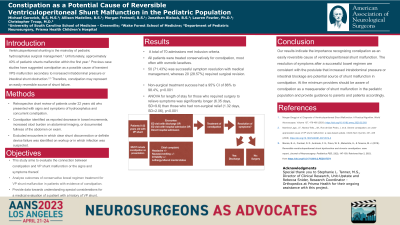Constipation as a Potential Cause of Reversible Ventriculoperitoneal Shunt Malfunction in the Pediatric Population
Friday, April 21, 2023


Michael C. Garovich, IV (he/him/his)
Medical Student
University of South Carolina School of Medicine Greenville
Greenville, South Carolina, United States
ePoster Presenter(s)
Introduction: Definitive hydrocephalus treatment is cerebrospinal fluid diversion via ventriculoperitoneal shunt (VPS). Malfunctions are common with obstruction being the leading cause across all age groups. Previous case studies have suggested constipation as a possible cause of transient VPS malfunction. Therefore, constipation may represent a reversible source of shunt failure.
Methods: A retrospective review was performed of individuals under 22 years old who presented at our institution with signs and symptoms of shunt malfunction and concurrent constipation. Patients were excluded if symptoms were due to suspected or confirmed infection, or if the initial workup revealed definite device disconnection. Using the electronic medical record, patient histories and radiographic imaging were reviewed to determine presence of hydrocephalus and constipation. Constipation was defined as a reported decrease in bowel movements, colon fullness on exam, and/or increased stool burden detected on imaging. An exact binomial test with exact Clooper-Pearson 95% confidence interval was run on the sample.
Results: 70 admissions meeting inclusion criteria were identified. All patients were treated conservatively for constipation, often with osmotic laxatives. Of the 70 patients, 50 (71.43%) saw successful symptom resolution with medical management, whereas 20 (28.57%) required surgical revision. The success of the non-surgical treatments for constipation had a 95% CI of 86% to 98.4%, p < 0.001. An analysis of variance demonstrates that length of stay for those who required surgery to relieve constipation was significantly longer (6.35 days, SD = 9.6) than those who had non-surgical relief (1.32 days, SD = 2.06), p < 0.001.
Conclusion : Constipation may precipitate shunt failure by affecting intraperitoneal pressure dynamics. Successful treatment of constipation can lead to resolution of presenting signs and symptoms of shunt dysfunction. This often results in decreased patient costs and length of stay, as well as unnecessary surgical intervention.
Methods: A retrospective review was performed of individuals under 22 years old who presented at our institution with signs and symptoms of shunt malfunction and concurrent constipation. Patients were excluded if symptoms were due to suspected or confirmed infection, or if the initial workup revealed definite device disconnection. Using the electronic medical record, patient histories and radiographic imaging were reviewed to determine presence of hydrocephalus and constipation. Constipation was defined as a reported decrease in bowel movements, colon fullness on exam, and/or increased stool burden detected on imaging. An exact binomial test with exact Clooper-Pearson 95% confidence interval was run on the sample.
Results: 70 admissions meeting inclusion criteria were identified. All patients were treated conservatively for constipation, often with osmotic laxatives. Of the 70 patients, 50 (71.43%) saw successful symptom resolution with medical management, whereas 20 (28.57%) required surgical revision. The success of the non-surgical treatments for constipation had a 95% CI of 86% to 98.4%, p < 0.001. An analysis of variance demonstrates that length of stay for those who required surgery to relieve constipation was significantly longer (6.35 days, SD = 9.6) than those who had non-surgical relief (1.32 days, SD = 2.06), p < 0.001.
Conclusion : Constipation may precipitate shunt failure by affecting intraperitoneal pressure dynamics. Successful treatment of constipation can lead to resolution of presenting signs and symptoms of shunt dysfunction. This often results in decreased patient costs and length of stay, as well as unnecessary surgical intervention.
